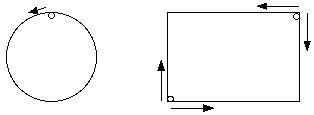- History
Handsaws have been around for thousands of years, ancient
woodworkers are depicted in Egyptian hieroglyphics sawing boards into
pieces. Ancient bow saws have been found in Japan, twenty-four saws from
eighteenth-century England are known to survive.
Disston is one of the most popular
brands of handsaws, the founder Henry Disston was born in Tewkesbury,
England in 1819, his family immigrated to America where he established
the company despite several personal tragedies. The DIsston Institute site gives a detailed account of what he went through as well as the company history.
The Basics
The cutting ability of a saw blade depends upon three measurements, rake, pitch and set.
- This is the angle at which the teeth are ground.

- This is the number of teeth per inch on the blade.

- The teeth are offset on each side
of the blade on a straight set blade, on fine toothed blades they may
have a wavy set in which several teeth in a row will be offset to the
same side.

The distance across the points of the teeth is known as the kerf or the width of the cut.
Saw Types
-
Back Saw
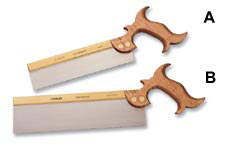
A handsaw with a rectangular blade with a reinforcing rib along the back, types include razor, veneer, dovetail and miter box.
Coping or Fret Saw
-
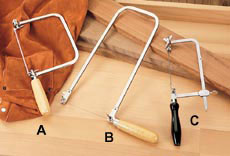
These saws use very narrow
blades so intricate designs can be cut. The blade can be rotated a full
360° to negotiate tight corners. Inside cuts are started by drilling a
small hole to allow the blade to pass through it, then the blade is
inserted into the saw frame. Deep throated saws called scroll saws with
frames having 18" clearance are available.
Using a Coping Saw
Hacksaw
-
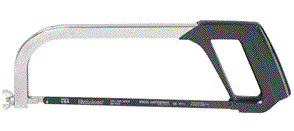
-
-
- Hacksaws are usually used for cutting metal. however they are also very handy for cutting dowels and thin wood strips.
-
- The blades
are easily interchangable, the thinner the material the finer the blade
should be, a rule of thumb is that three teeth should be on the material
at all times.
-
- Hold the
material being cut in a vise positioned so that the cut is close to the
edge of the jaws, use slow strokes (60 per minute) with not too much
downward pressure.
-
- If a
blade is changed in the middle of a cut reverse the material and cut
from the other side toward the orginal cut. A new blade will have more
set than a used blade and will be ruined if cut is continued.
-
Handsaws

-
Handsaws are available
in many sizes and configurations, a good general purpose saw is 26" long
and has 8 teeth per inch. Crosscut saws (to cut across the grain) have
teeth with a negative rake, ripping saws (to cut in the direction of the
grain) have a zero rake.
-
-
-
- How to make a cross cut
- Cross
cuts go against the grain, mark the cut with a square, guide the side
of the blade with the knuckle of your thumb. Start the cut by pulling up
on the handsaw two or three times, then push the saw forward at about a
45° angle, continue with full even strokes.
-
- How to make a rip cut
- Rip
cuts go in the direction of the grain of the wood, mark a line to
follow, start the same way as cross cutting, then continue with full
strokes at about a 60° angle. If it is a long cut use a wedge to spread
the wood apart.
-
-
-

-
- American Style
-
-
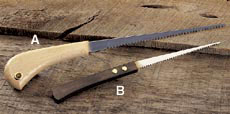
- Japanese Style
-
-
These saws have
narrow blades to cut along curves or short distances. To start inside
cuts one or more holes are drilled, depending on the shape of the
cut-out. On longer inside straight cuts use the keyhole saw to make a
cut long enough so that a regular handsaw can be inserted to finish the
cut.
-
-
-
- Frame saws are
useful tools for a great many jobs—often called bow saws, the
traditional shape has two hardwood handles separated by a wood bar, with
the blade below the bar and a twisted wire or cable above. The result
is a squatty H shape that makes handling very easy. The wire is turned
and tightened to add tension to the blade, which then cuts straight and
true.
-
- The teeth on these
saws cut on the pull stroke, some have teeth on both edges of the
blade, offering dual TPI. Dozuki, Ryoba, and Razor are popular styles.
-
-
- Timber and Log Saws
-

-
- Perfect for timber
framing, log building, or any heavy cutting job. Use the starting teeth
to introduce a kerf, then the 3 TPI main teeth, which cut on both the
push and pull stroke, to quickly slice through the toughest jobs.
|









